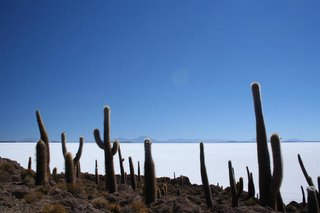Arequipa

After arriving from Bolivia we spent a couple of days relaxing in Arequipa. It is Peru's second biggest city and quite a cosmopolitan place with lots of nice bars and restaurants. The highlight of our time in Arequipa was a visit to the incredibly beautiful Santa Catalina Monastery.
Founded in 1575 it used to be home to about two hundred nuns and their three hundred servants. None of these women were ever allowed to leave the monastery which is in the middle of the city but surrounded by huge walls. In 1970 the nuns opened the majority of the monastery to the public who were allowed in for the first time since it was built. There is still a corner of the monastery though where the remaining 30 nuns live in seclusion from the outside world.
Walking around all the courtyards, streets and rooms the monastery felt like a small town in its own right, even though in places you could hear traffic noise from outside. There was a really creepy room where the nuns used to be laid out before burial complete with portraits of about 15 nuns, all painted after they had died!
After looking around Arequipa we headed off to the Colca Canyon about 200 kilometres away. The Colca Canyon is one of the deepest in the world and we were planning to do a three day trek. The plan was to descend to the bottom of the canyon on the first day, walk across it on the second day and back up it on the third day. Unfortunately we hadn't factored in Steve's legs!
The first day went reasonably well but by the second day Steve was hobbling along like a wounded dog. We had brought along a guide called Joanna who got into quite a bad temper when she realised we weren't going to be walking fast enough to stick to her preplanned schedule. She didn't actually say anything to us directly she just asked us what time it was every ten minutes and then sighed loudly until we were both ready to nudge her off the edge.
By the second night Steve was barely able to walk from our bamboo hut to the dinner table, so we decided that we weren't going anywhere the following morning, let alone on a 5hr hike up to the top of a huge canyon. To our relief Joanna went back alone that morning leaving us to relax. The hostel that we were staying at, at the base of the canyon, was quite a fun place to hang out with a slightly grubby swimming pool, two cute baby ducks and an amazing view.
In the end Steve´s state forced us to suffer the indignity of having to hire out two mules to take us to the top of the canyon. For a reason we couldn't quite work out the mule owner would only take them up at 3am in the morning. So today we got up in the middle of the night, got on to our mules and started heading up the canyon. To start with I was convinced this was a horrible form of animal torture with the added disadvantage of potentially dropping off a cliff edge. However we realised that our mules were as hard as nails when they started racing each other in a competition to see which one would be in front. Steve hung his head in shame as we passed fellow hikers walking up the canyon the old fashioned way. However, the view into the canyon at dawn was pretty spectacular.
We are now back in Arequipa recovering for a day before heading off to Nasca tomorrow night to see the ancient lines in the desert.


